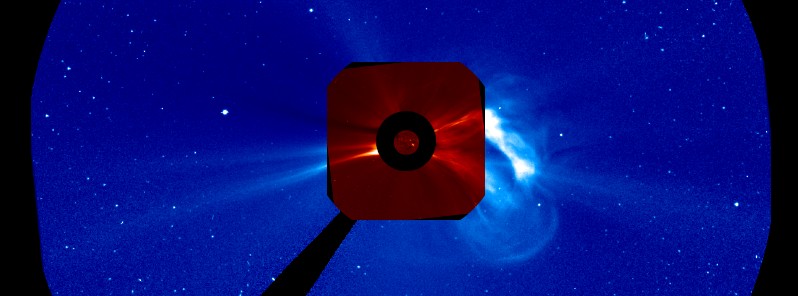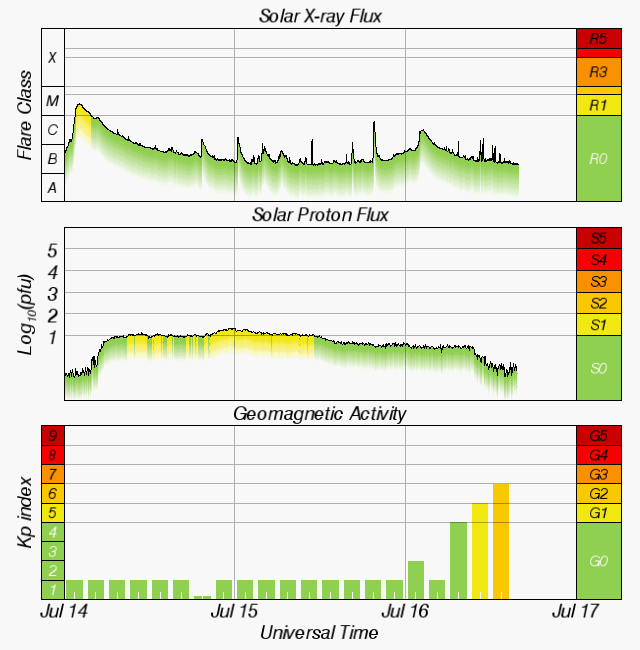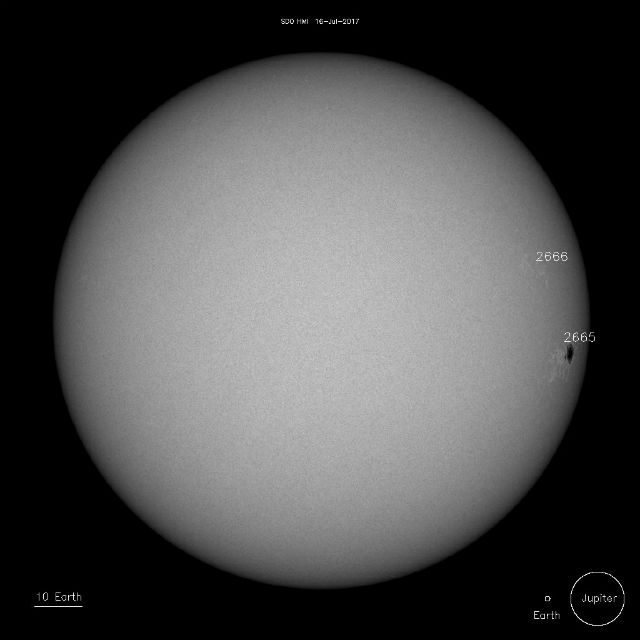CME hits Earth, sparks G2 – Moderate geomagnetic storm

A coronal mass ejection (CME) produced by the July 14th M2.4 long-duration solar flare hit Earth's magnetic field at 06:01 UTC on July 16, 2017. G2 – Moderate geomagnetic storming started 9 hours later. The S1 Minor solar radiation storm that started at 09:00 UTC on July 14 ended at 11:15 UTC on July 15.
Solar wind parameters were steady at background levels until 05:15 UTC when an interplanetary shock, likely associated with the arrival of the July 14th CME, reached DSCOVR spacecraft located at L1 point, approximately 1.6 million km (1 million miles) away from the Earth.
Solar wind speeds, as measured by the spacecraft, sharply increased from around 320 km/s to 502 km/s. Following the shock, solar wind speeds slowly increased to a peak value of 537 km/s at 10:39 UTC. Total field strength values reached 27 nT and Bz was sustained at around -22 nT for a prolonged period following the shock arrival.
Back at Earth, geomagnetic K-index of 5 (G1 – Minor geomagnetic storm) threshold was reached at 11:05 UTC and 13:08 UTC. Geomagnetic K-index of 6 (G2 – Moderate geomagnetic storm) threshold was first reached at 14:54 UTC.
Under G2 conditions, area of impact is primarily poleward of 55 degrees Geomagnetic Latitude. Power grid fluctuations can occur and high-latitude power systems may experience voltage alarms. Satellite orientation irregularities may occur as well as increased drag on low Earth-orbit satellites. HF (high frequency) radio propagation can fade at higher latitudes and aurora may be seen as low as New York to Wisconsin to Washington state.

Solar wind parameters are expected to remain enhanced over the next two days (July 16 and 17) as the CME passes. Quiet to active levels are expected on July 18 as CME effects slowly diminish.
Meanwhile, the greater than 2 MeV electron flux was at normal to moderate levels over the past 24 hours with a peak flux of 624 pfu observed at 16:10 UTC on July 15. It is expected to be at normal levels on July 16 and 17 due to elevated geomagnetic field activity associated with CME passage. Moderate to high levels are expected on July 18 following an enhanced near-Earth solar wind environment.
The greater than 10 MeV proton event (S1 Minor) that began at 09:00 UTC on July 14, reached a maximum flux of 22 pfu at 23:20 UTC and ended at 11:15 UTC on July 15. It is expected to be at near-background levels on July 16 and return to background levels on July 17 and 18.
If you missed the July 14th solar flare you can find the details and all necessary imagery at the following link: https://watchers.news/2017/07…
CME produced by the M2.4 long-duration solar flare on July 14, 2017
Active Region 2665, responsible for this amazing CME, will soon start its farside rotation. It still has Beta magnetic configuration and is capable of producing moderate to strong eruptions. Its location does not favor Earth-directed CMEs, but should one erupt we'll probably experience another solar radiation storm.
There are currently only two active regions on the Earth-facing Sun and it seems spotless days are ahead.

Sunspots on July 16, 2017. Credit: NASA SDO/HMI.
Solar activity is expected to be at low levels with a chance for M-class solar flare over the next three days.
SWPC Alerts
Space Weather Message Code: ALTK06
Serial Number: 436
Issue Time: 2017 Jul 16 1455 UTC
ALERT: Geomagnetic K-index of 6
Threshold Reached: 2017 Jul16 1454 UTC
Synoptic Period: 1200-1500 UTC
Active Warning: Yes
NOAA Scale: G2 – Moderate
Potential Impacts: Area of impact primarily poleward of 55 degrees Geomagnetic Latitude.
Induced Currents – Power grid fluctuations can occur. High-latitude power systems may experience voltage alarms.
Spacecraft – Satellite orientation irregularities may occur; increased drag on low Earth-orbit satellites is possible.
Radio – HF (high frequency) radio propagation can fade at higher latitudes.
Aurora – Aurora may be seen as low as New York to Wisconsin to Washington state.
***
Space Weather Message Code: ALTK05
Serial Number: 1123
Issue Time: 2017 Jul 16 1309 UTC
ALERT: Geomagnetic K-index of 5
Threshold Reached: 2017 Jul16 1308 UTC
Synoptic Period: 1200-1500 UTC
Active Warning: Yes
NOAA Scale: G1 – Minor
Potential Impacts: Area of impact primarily poleward of 60 degrees Geomagnetic Latitude.
Induced Currents – Weak power grid fluctuations can occur.
Spacecraft – Minor impact on satellite operations possible.
Aurora – Aurora may be visible at high latitudes, i.e., northern tier of the U.S. such as northern Michigan and Maine.
***
Space Weather Message Code: ALTK05
Serial Number: 1122
Issue Time: 2017 Jul 16 1106 UTC
ALERT: Geomagnetic K-index of 5
Threshold Reached: 2017 Jul 16 1105 UTC
Synoptic Period: 0900-1200 UTC
Active Warning: Yes
NOAA Scale: G1 – Minor
Potential Impacts: Area of impact primarily poleward of 60 degrees Geomagnetic Latitude.
Induced Currents – Weak power grid fluctuations can occur.
Spacecraft – Minor impact on satellite operations possible.
Aurora – Aurora may be visible at high latitudes, i.e., northern tier of the U.S. such as northern Michigan and Maine.
***
Space Weather Message Code: WARK06
Serial Number: 388
Issue Time: 2017 Jul 16 1038 UTC
WARNING: Geomagnetic K-Index of 6 expected
Valid From: 2017 Jul 16 1040 UTC
Valid To: 2017 Jul 16 1800 UTC
Warning Condition: Onset
NOAA Scale: G2 – Moderate
NOAA Space Weather Scale descriptions can be found at
www.swpc.noaa.gov/noaa-scales-explanation
Potential Impacts: Area of impact primarily poleward of 55 degrees Geomagnetic Latitude.
Induced Currents – Power grid fluctuations can occur. High-latitude power systems may experience voltage alarms.
Spacecraft – Satellite orientation irregularities may occur; increased drag on low Earth-orbit satellites is possible.
Radio – HF (high frequency) radio propagation can fade at higher latitudes.
Aurora – Aurora may be seen as low as New York to Wisconsin to Washington state.
***
Space Weather Message Code: SUMSUD
Serial Number: 222
Issue Time: 2017 Jul 16 0609 UTC
SUMMARY: Geomagnetic Sudden Impulse
Observed: 2017 Jul 16 0601 UTC
Deviation: 40 nT
Station: HAD
Featured image: Coronal Mass Ejection (CME) produced by the July 14, 2017 long-duration M2.4 solar flare. Credit: ESA/NASA SOHO LASCO C2 and C3, NASA SDO/AIA 304

I’m from ct what direction would I have to look at to c the aurora?